Subpixel Analysis of Primary and Secondary Infrared Emitters with Nighttime VIIRS Data
Abstract
:1. Introduction
1.1. Remote Sensing Background
1.2. Temperature Ranges of Fire Pixel Components
1.3. Study Objectives
2. Materials and Methods
2.1. VNF Detection Algorithms
2.2. Types of VNF Detections
- Type 0—Single-band detections. Typically M11 (SWIR). In data collected prior to nighttime M11 collections, it was M10. No Planck curve fitting—no temperature can be calculated.
- Type 1—NIR and SWIR detection—no MWIR detection. The most common are detections in the two SWIR bands (M10 and M11). Processed with the VNF V.3 dual Planck curve fitting method for a single IR emitter and background.
- Type 2—M11 and MWIR detection. Processed with the VNF V.3 dual Planck curve fitting method for a single IR emitter and background.
- Type 3—MWIR only—a rare occurrence. Processed with the VNF V.3 dual Planck curve fitting method for a single IR emitter and background.
- Type 4—Has detection in two SWIR bands and MWIR. May have NIR detection as well. The primary and secondary emitter analysis is restricted to Type 4 detections.
- Type 5—Pixels that yield spurious results revert back to the original dual Planck curve fitting with a single IR emitter plus background.
2.3. Planck Curve Fitting
2.4. Saturation
2.5. Atmospheric Correction
2.6. Flaming Subtractive Method
2.7. Triple Curve Methods
- Unconstrained—observed radiances only.
- Constrained by the primary emitter temperature calculated from Planck curve fitting of the NIR and SWIR detection radiances.
- Constrained by the local background temperature.
- Constrained by the primary emitter temperature and local background temperature.
2.8. Rating
3. Results
3.1. Scoring the Methods
3.2. Examples of Good Fits
3.3. Examples of Misfits
3.4. Temperature versus Source Area Scattergrams and Temperature Histograms
3.5. Temperature Montage
3.6. Atmospheric Correction Effect
4. Discussions
5. Conclusions
Author Contributions
Funding
Informed Consent Statement
Data Availability Statement
Acknowledgments
Conflicts of Interest
References
- Planck, M. The Theory of Heat Radiation, 2nd ed.; Masius, M., Translator; P. Blakiston’s Son & Co.: Philadelphia, PA, USA, 1914. [Google Scholar]
- Weinreb, M.P.; Hill, M.L. Calculation of Atmospheric Radiances and Brightness Temperatures: In infrared Window Channels of Satellite Radiometers; No. 80; US Department of Commerce, National Oceanic and Atmospheric Administration, National Environmental Satellite Service: Washington, DC, USA, 1980.
- Planck, M. On the law of distribution of energy in the normal spectrum. Ann. Phys. 1901, 4, 553. [Google Scholar] [CrossRef]
- Planck, M. The theory of heat radiation. Entropie 1900, 144, 164. [Google Scholar]
- Dozier, J. A method for satellite identification of surface temperature fields of sub-pixel resolution. Remote Sens. Environ. 1981, 11, 221–229. [Google Scholar] [CrossRef]
- Elvidge, C.D.; Zhizhin, M.; Hsu, F.-C.; Baugh, K.E. VIIRS nightfire: Satellite pyrometry at night. Remote Sens. 2013, 5, 4423–4449. [Google Scholar] [CrossRef] [Green Version]
- Lee, T.F.; Tag, P.M. Improved detection of hotspots using the AVHRR 3.7-um channel. Bull. Am. Meteorol. Soc. 1990, 71, 1722–1730. [Google Scholar] [CrossRef] [Green Version]
- Justice, C.; Giglio, L.; Korontzi, S.; Owens, J.; Morisette, J.; Roy, D.; Descloitres, J.; Alleaume, S.; Petitcolin, F.; Kaufman, Y. The MODIS fire products. Remote Sens. Environ. 2002, 83, 244–262. [Google Scholar] [CrossRef]
- Li, F.; Zhang, X.; Kondragunta, S.; Csiszar, I. Comparison of fire radiative power estimates from VIIRS and MODIS observations. J. Geophys. Res. Atmos. 2018, 123, 4545–4563. [Google Scholar] [CrossRef]
- Wooster, M.J.; Roberts, G.; Perry, G.; Kaufman, Y.J. Retrieval of biomass combustion rates and totals from fire radiative power observations: FRP derivation and calibration relationships between biomass consumption and fire radiative energy release. J. Geophys. Res. Atmos. 2005, 110, 24. [Google Scholar] [CrossRef]
- Fisher, D.; Wooster, M.J. Shortwave IR adaption of the mid-infrared radiance method of fire radiative power (FRP) retrieval for assessing industrial gas flaring output. Remote Sens. 2018, 10, 305. [Google Scholar] [CrossRef] [Green Version]
- Elvidge, C.D.; Zhizhin, M.; Hsu, F.-C.; Baugh, K.; Khomarudin, M.R.; Vetrita, Y.; Sofan, P.; Hilman, D. Long-wave infrared identification of smoldering peat fires in Indonesia with nighttime Landsat data. Environ. Res. Lett. 2015, 10, 065002. [Google Scholar] [CrossRef] [Green Version]
- Elvidge, C.D.; Zhizhin, M.; Baugh, K.; Hsu, F.-C. Identification of Smoldering Peatland Fires in Indonesia via Triple-Phase Temperature Analysis of VIIRS Nighttime Data. In Biomass Burning in South and Southeast Asia; CRC Press: Boca Raton, FL, USA, 2021; pp. 25–38. [Google Scholar]
- Elvidge, C.D.; Zhizhin, M.; Baugh, K.; Hsu, F.-C.; Ghosh, T. Extending Nighttime Combustion Source Detection Limits with Short Wavelength VIIRS Data. Remote Sens. 2019, 11, 395. [Google Scholar] [CrossRef] [Green Version]
- Ward, D. Combustion chemistry and smoke. In Forest Fires; Academic Press: Cambridge, MA, USA, 2001; pp. 55–77. [Google Scholar]
- Bodí, M.B.; Martin, D.A.; Balfour, V.N.; Santín, C.; Doerr, S.H.; Pereira, P.; Cerdà, A.; Mataix-Solera, J. Wildland fire ash: Production, composition and eco-hydro-geomorphic effects. Earth-Sci. Rev. 2014, 130, 103–127. [Google Scholar] [CrossRef]
- Rein, G. Smoldering Combustion, Chapter 19. In SFPE Handbook of Fire Protection Engineering, 5th ed.; Springer: Berlin/Heidelberg, Germany, 2016; pp. 581–603. Available online: http://link.springer.com/chapter/10.1007/978-1-4939-2565-0_19 (accessed on 31 October 2021).
- Stubenrauch, C.J.; Rossow, W.B.; Kinne, S.; Ackerman, S.; Cesana, G.; Chepfer, H.; Di Girolamo, L.; Getzewich, B.; Guignard, A.; Heidinger, A.; et al. Assessment of global cloud datasets from satellites: Project and database initiated by the GEWEX radiation panel. Bull. Am. Meteorol. Soc. 2013, 94, 1031–1049. [Google Scholar] [CrossRef]
- Webb, P. Introduction to Oceanography; Roger Williams University Pressbooks: Bristol, RI, USA, 2019. [Google Scholar]
- Wan, Z.; Zhang, Y.; Zhang, Q.; Li, Z.-L. Quality assessment and validation of the MODIS global land surface temperature. Int. J. Remote Sens. 2004, 25, 261–274. [Google Scholar] [CrossRef]
- Safdari, M.S.; Rahmati, M.; Amini, E.; Howarth, J.E.; Berryhill, J.P.; Dietenberger, M.; Weise, D.R.; Fletcher, T.H. Characterization of pyrolysis products from fast pyrolysis of live and dead vegetation native to the Southern United States. Fuel 2018, 229, 151–166. [Google Scholar] [CrossRef]
- Wotton, B.M.; Gould, J.S.; McCaw, W.L.; Cheney, N.P.; Taylor, S.W. Flame temperature and residence time of fires in dry eucalypt forest. Int. J. Wildland Fire 2011, 21, 270–281. [Google Scholar] [CrossRef]
- Elvidge, C.D.; Zhizhin, M.; Baugh, K.; Hsu, F.-C.; Ghosh, T. Methods for global survey of natural gas flaring from visible infrared imaging radiometer suite data. Energies 2016, 9, 14. [Google Scholar] [CrossRef]
- Lagarias, J.C.; Reeds, J.A.; Wright, M.H.; Wright, P.E. Convergence properties of the Nelder-Mead simplex method in low dimensions. SIAM J. Optim. 1998, 9, 112–147. [Google Scholar] [CrossRef] [Green Version]
- Emde, C.; Buras-Schnell, R.; Kylling, A.; Mayer, B.; Gasteiger, J.; Hamann, U.; Kylling, J.; Richter, B.; Pause, C.; Dowling, T.; et al. The libradtran software package for radiative transfer calculations (version 2.0.1). Geosci. Model Dev. 2016, 9, 1647–1672. [Google Scholar] [CrossRef] [Green Version]
- Grassotti, C.; Liu, S.; Honeyager, R.; Lee, Y.K.; Liu, Q.; Forsythe, J.; Chirokova, G. NOAA’s Microwave Integrated Retrieval System (MiRS): Operational Update, Applications, and Recent Scientific Progress. In Proceedings of the 2019 Joint Satellite Conference, AMS, Boston, MA, USA, 29 September–4 October 2019. [Google Scholar]
- Vanhellemont, Q. Automated water surface temperature retrieval from Landsat 8/TIRS. Remote Sens. Environ. 2020, 237, 111518. [Google Scholar] [CrossRef]
- Barbosa, P.M.; Stroppiana, D.; Grégoire, J.M.; Cardoso Pereira, J.M. An assessment of vegetation fire in Africa (1981–1991): Burned areas, burned biomass, and atmospheric emissions. Glob. Biogeochem. Cycles 1999, 13, 933–950. [Google Scholar] [CrossRef]


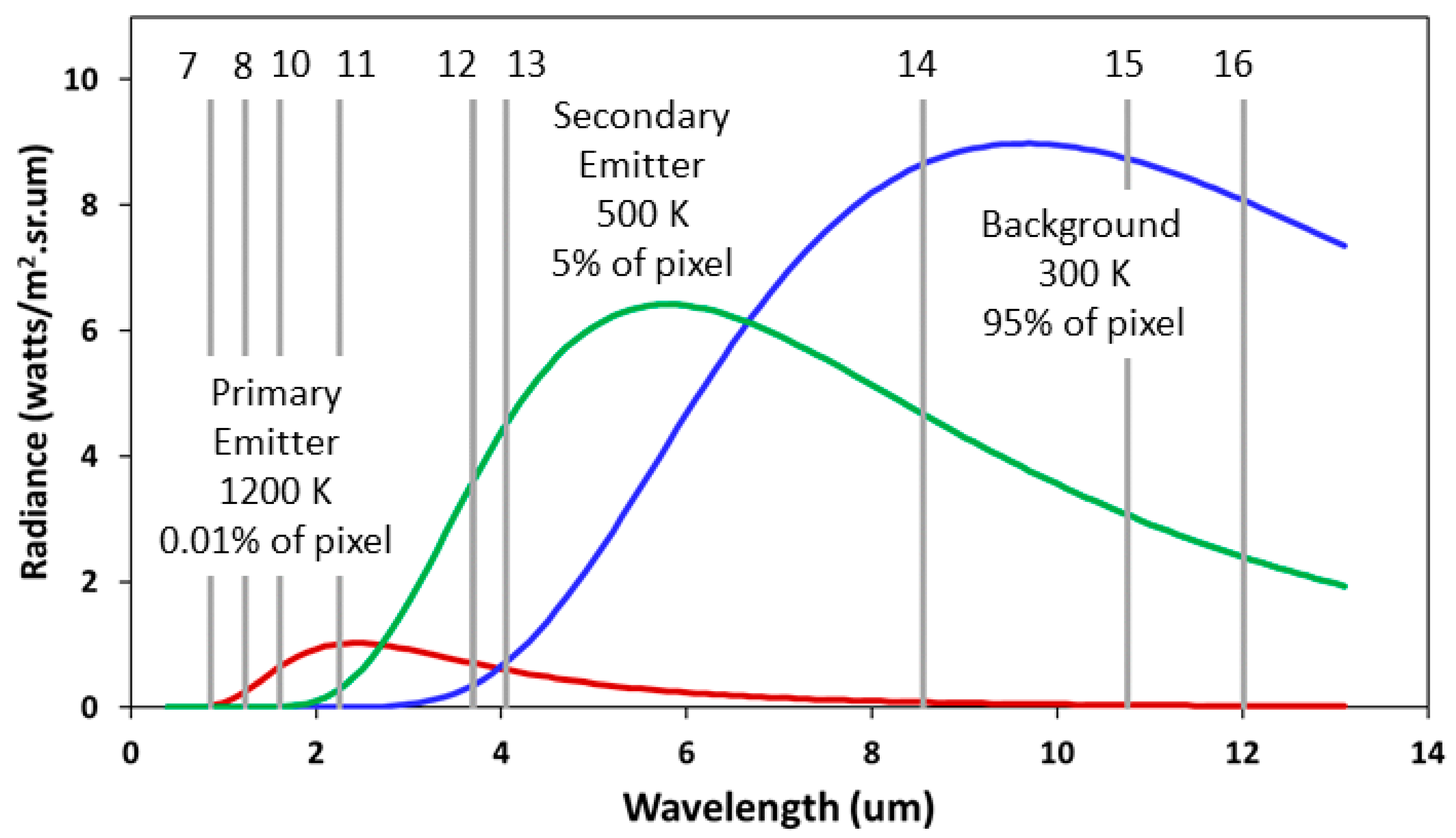
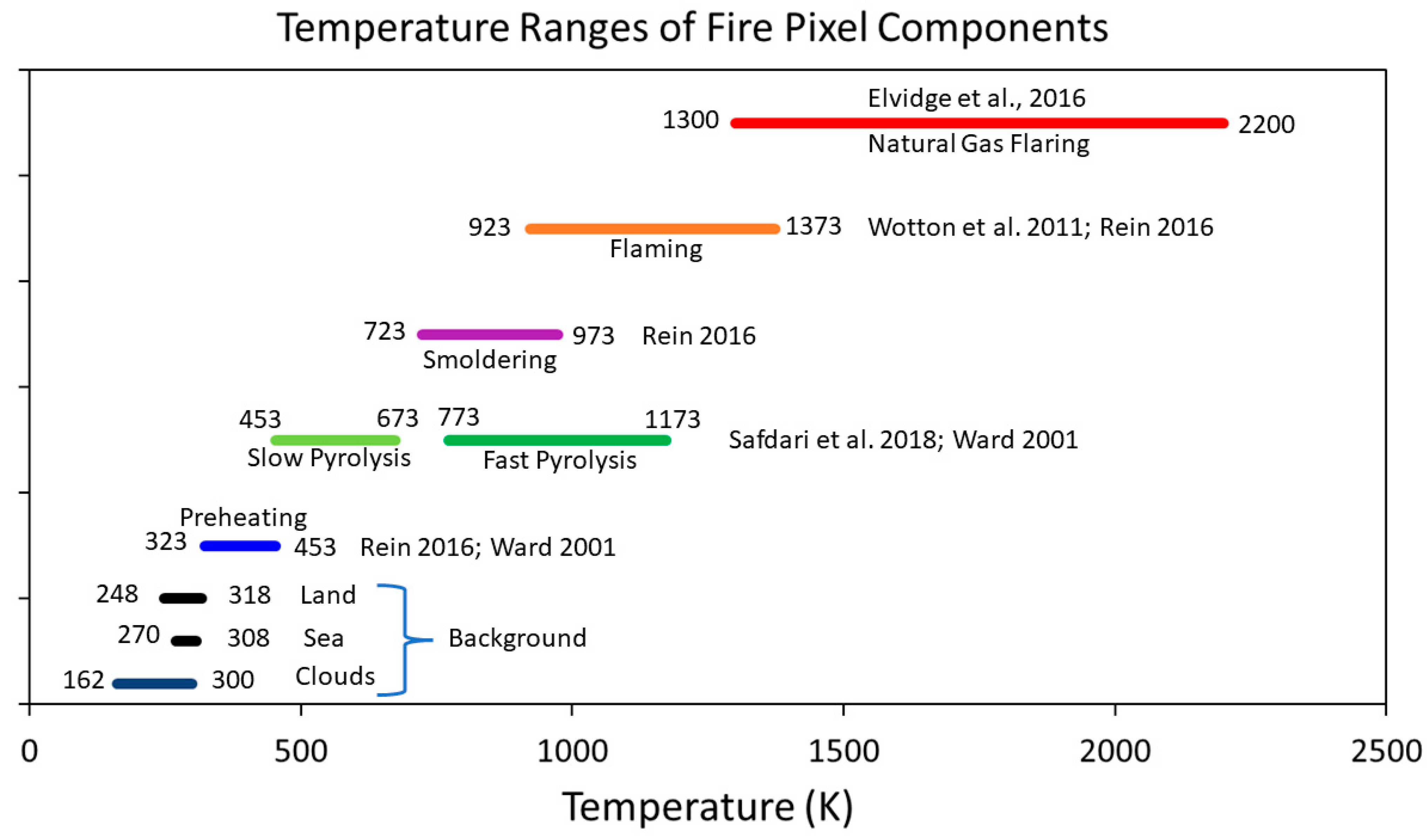
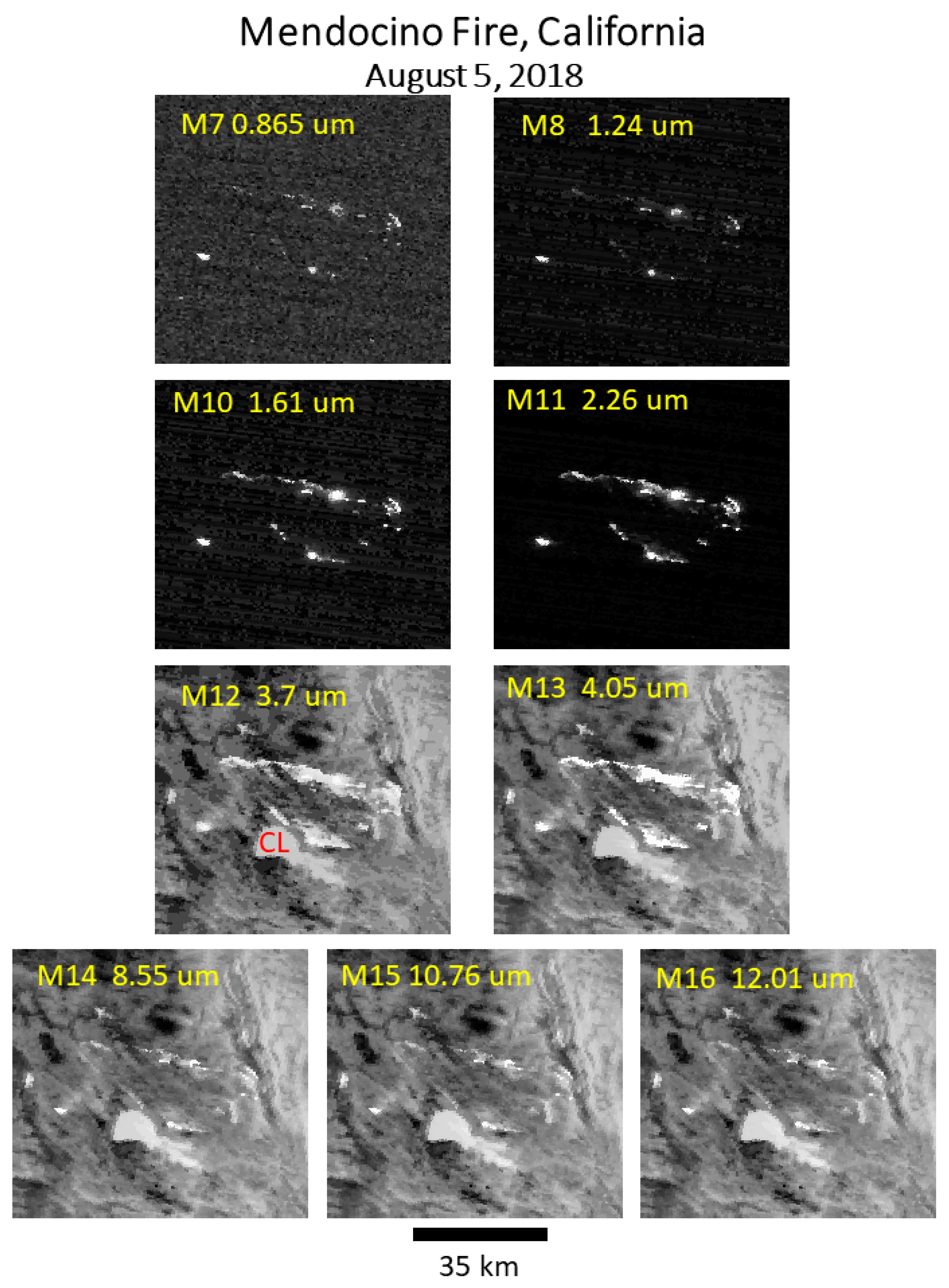


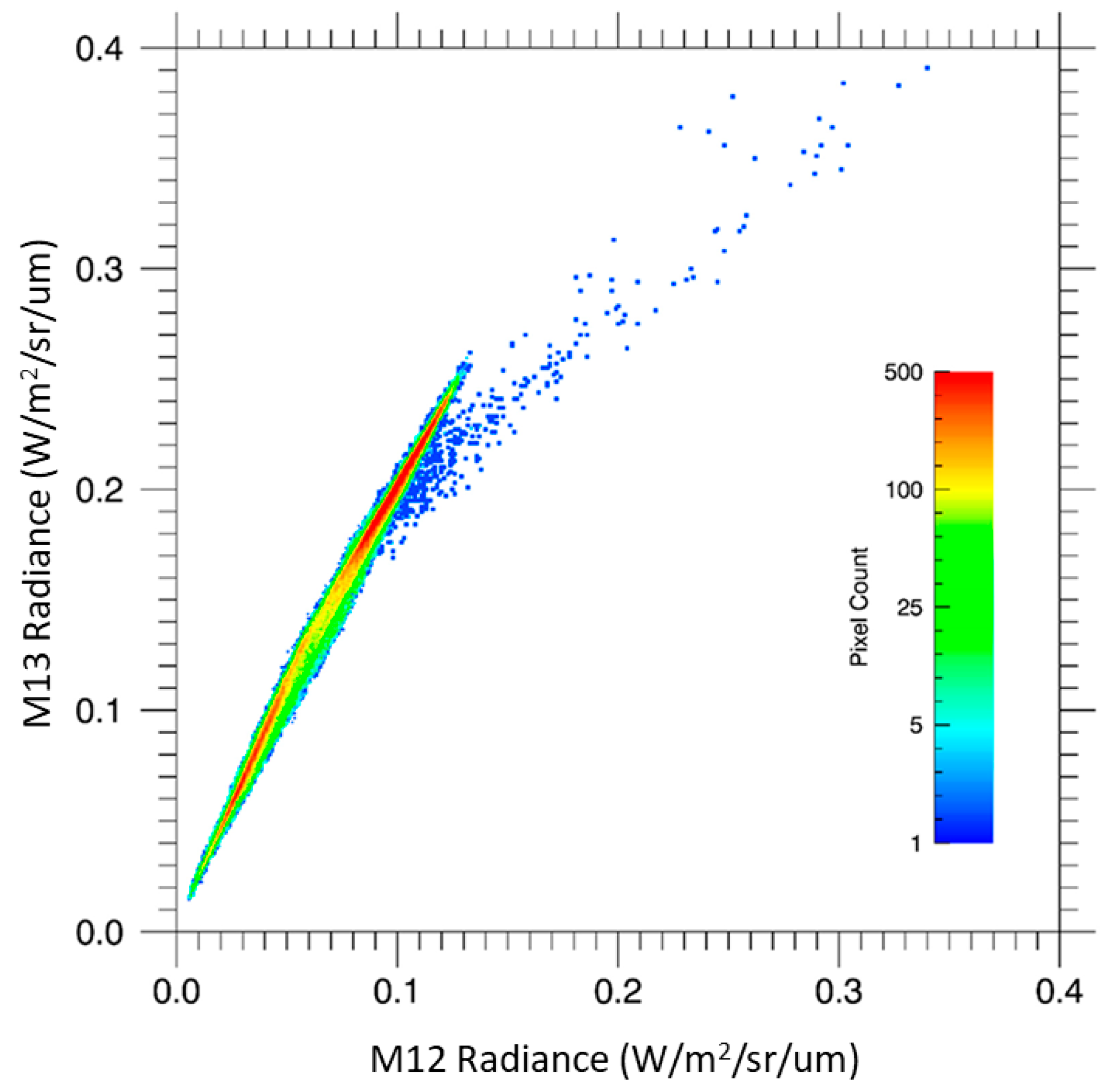
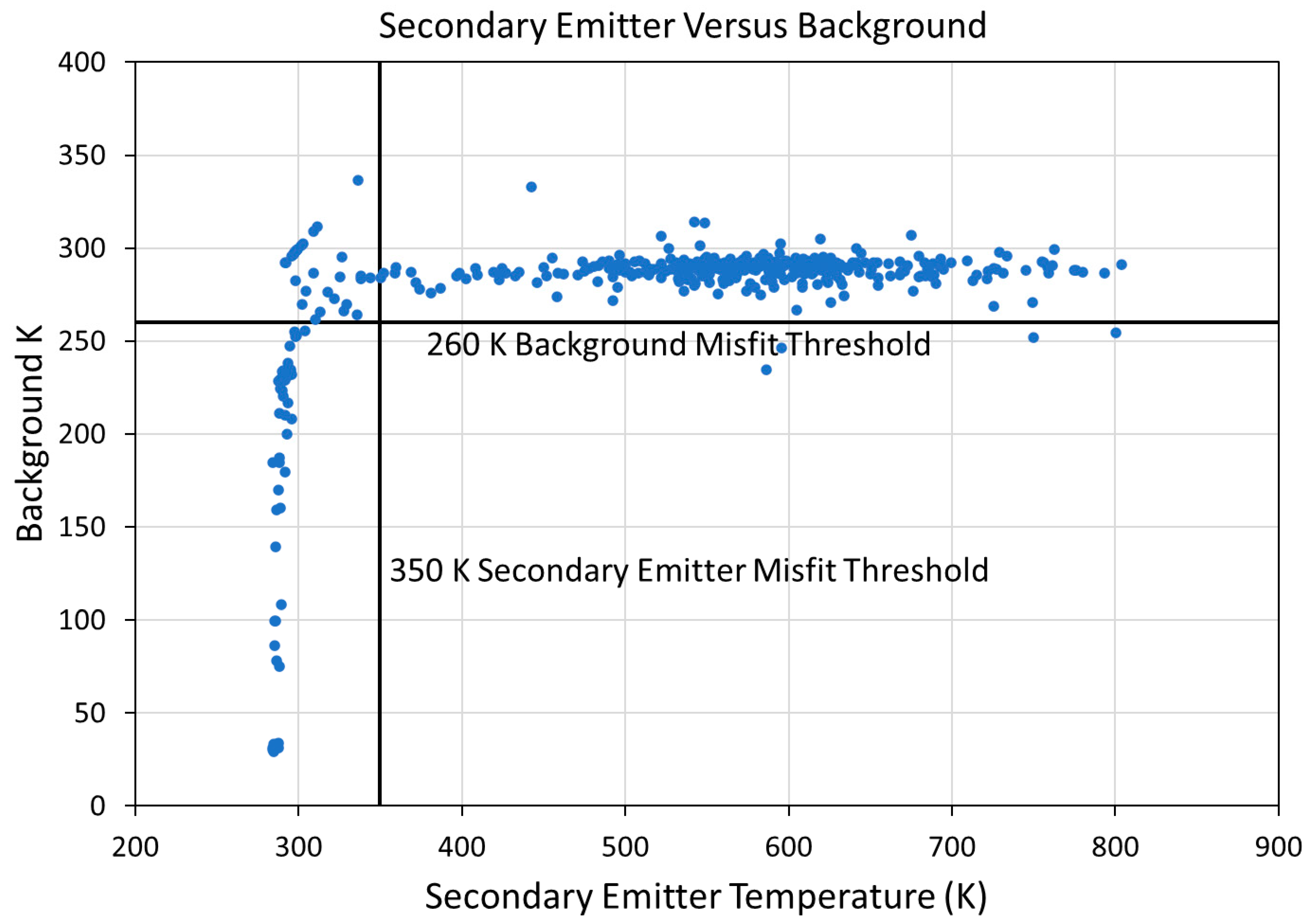
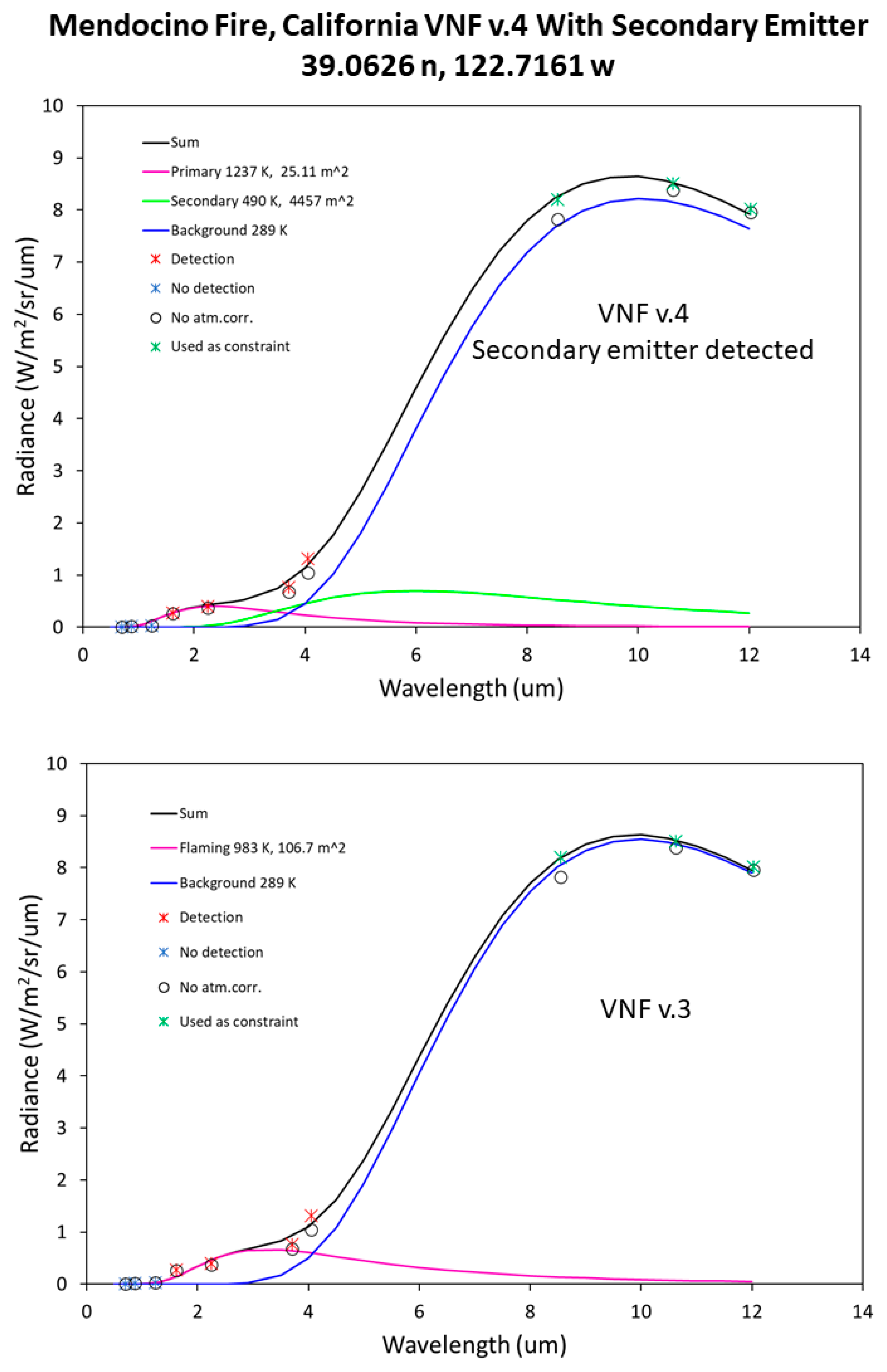
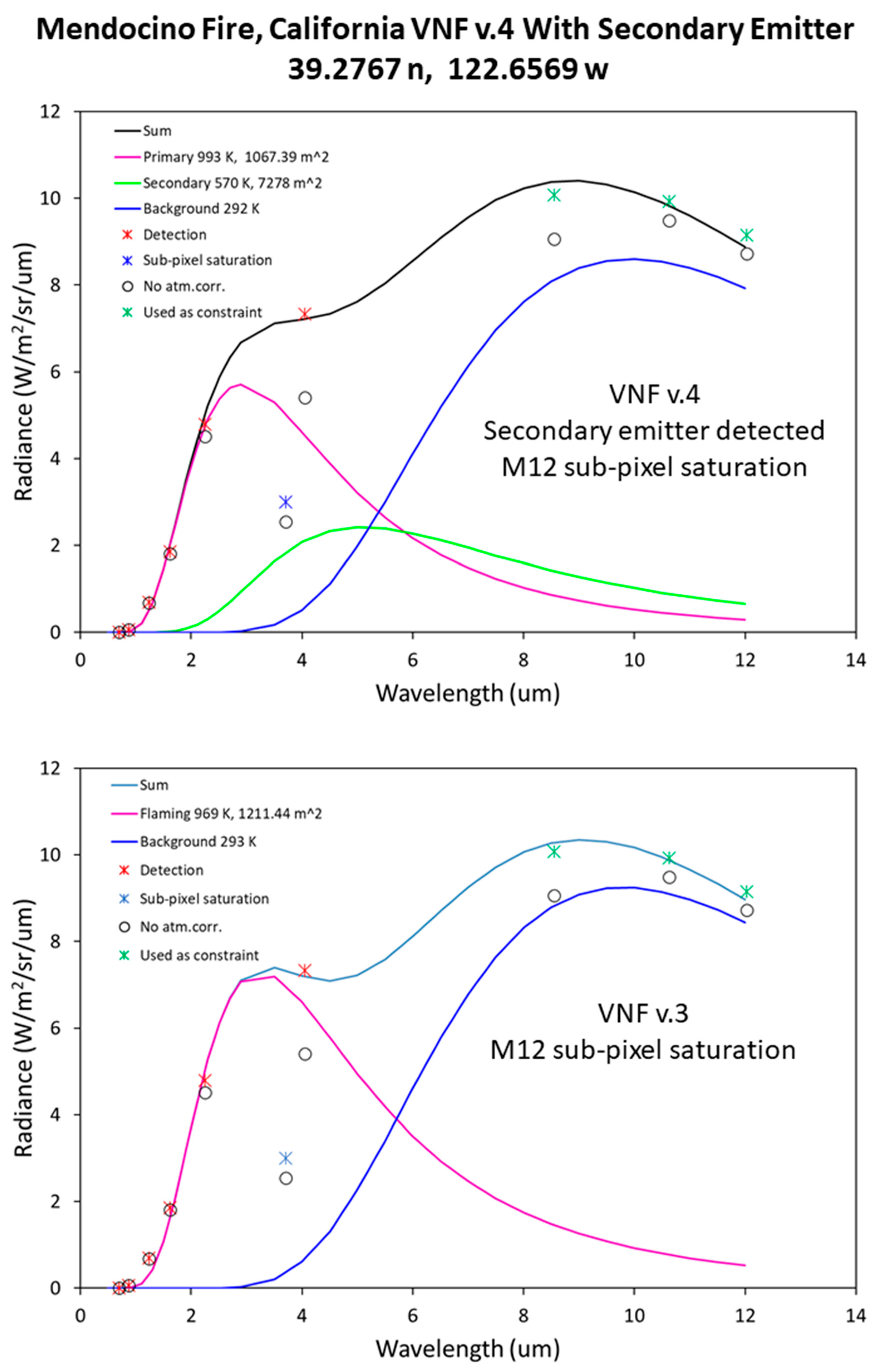
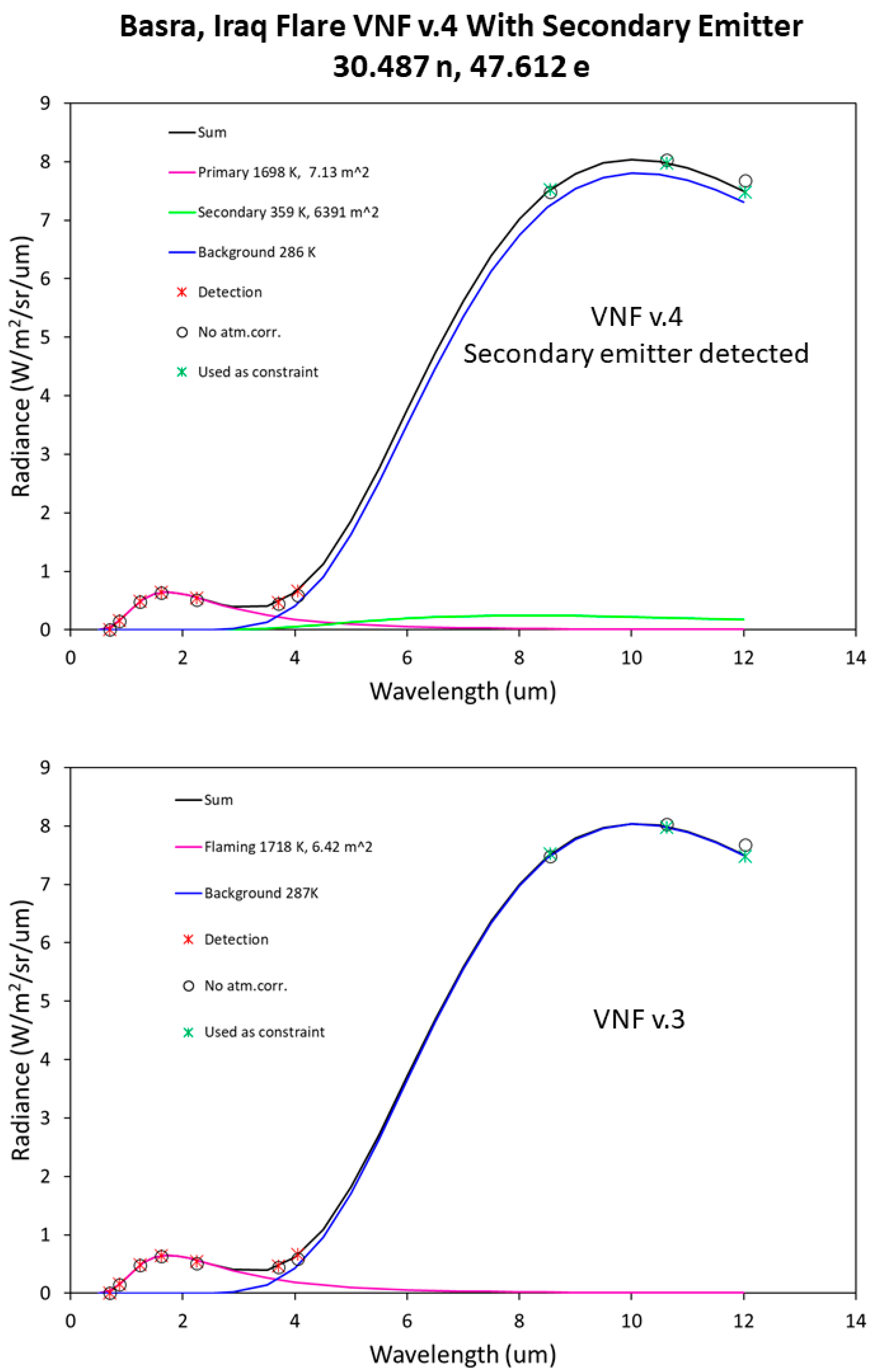
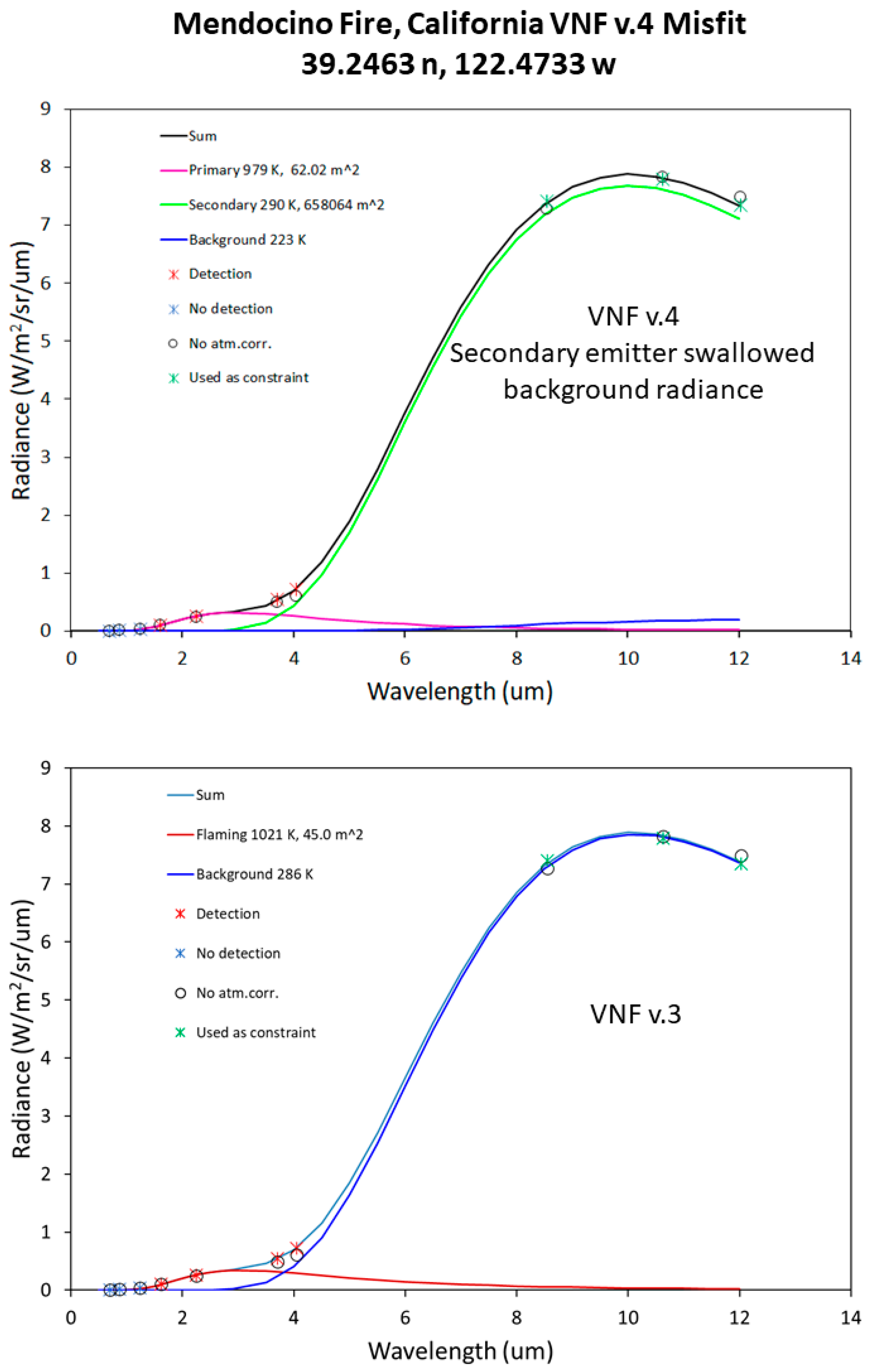
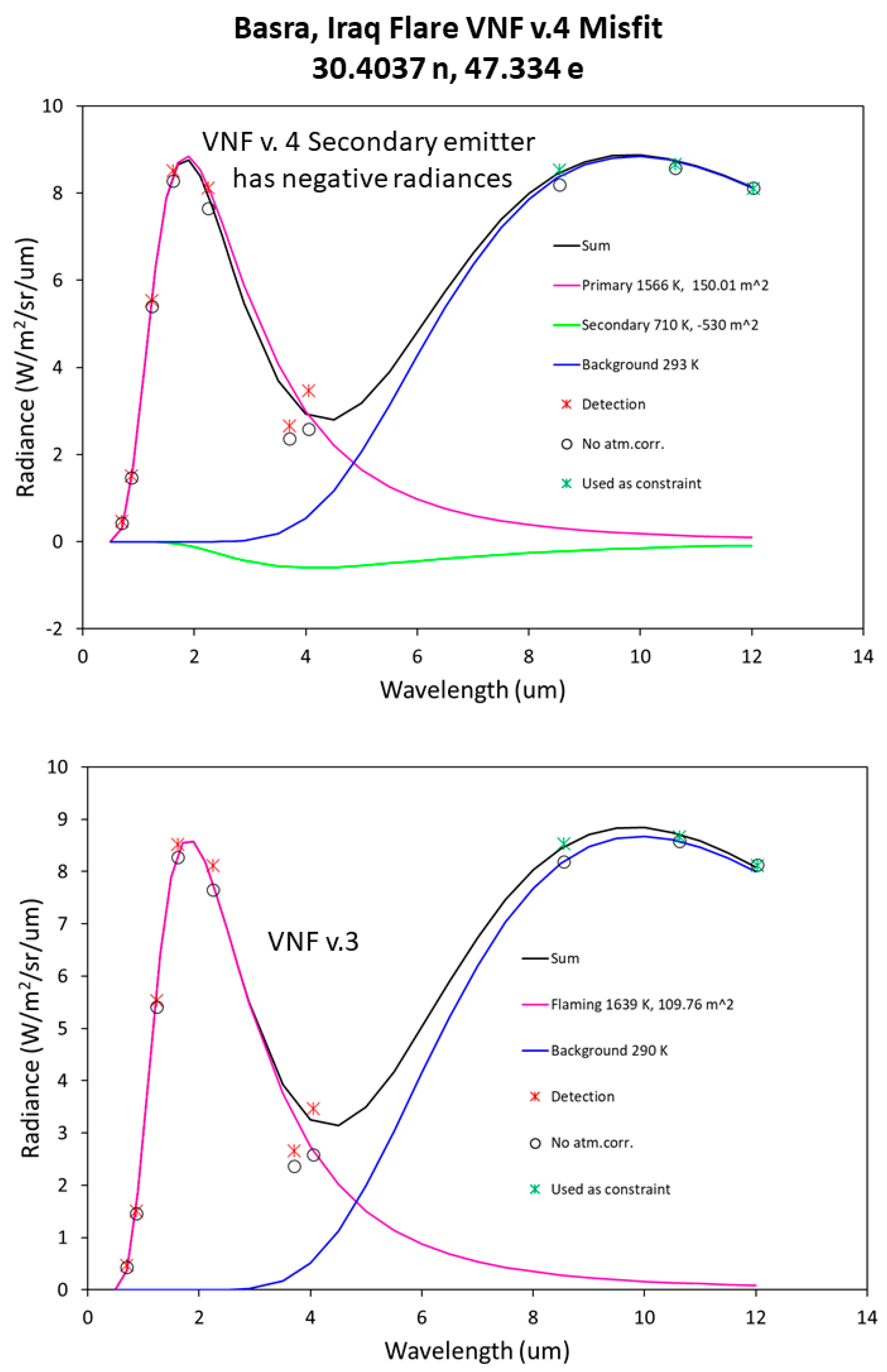

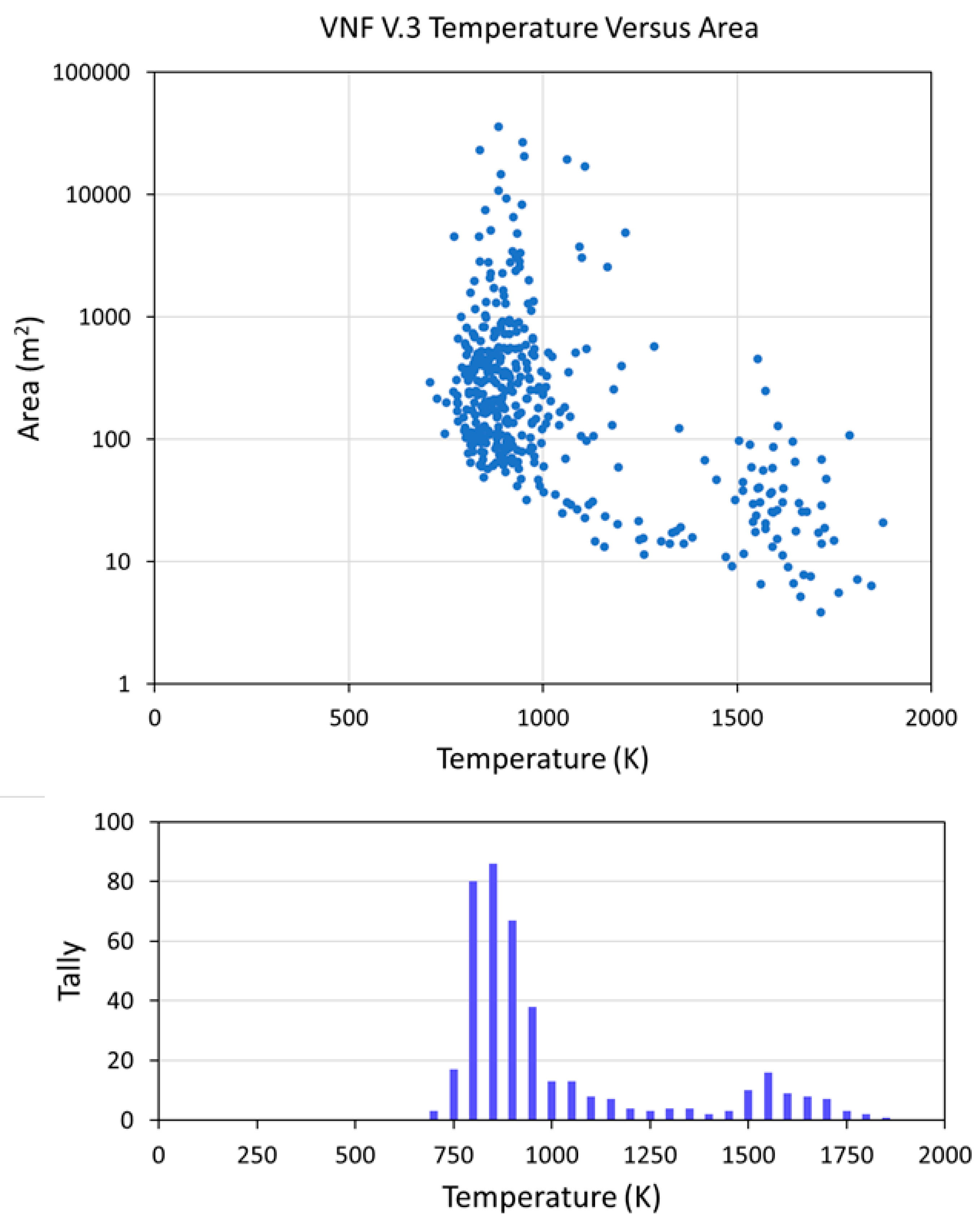
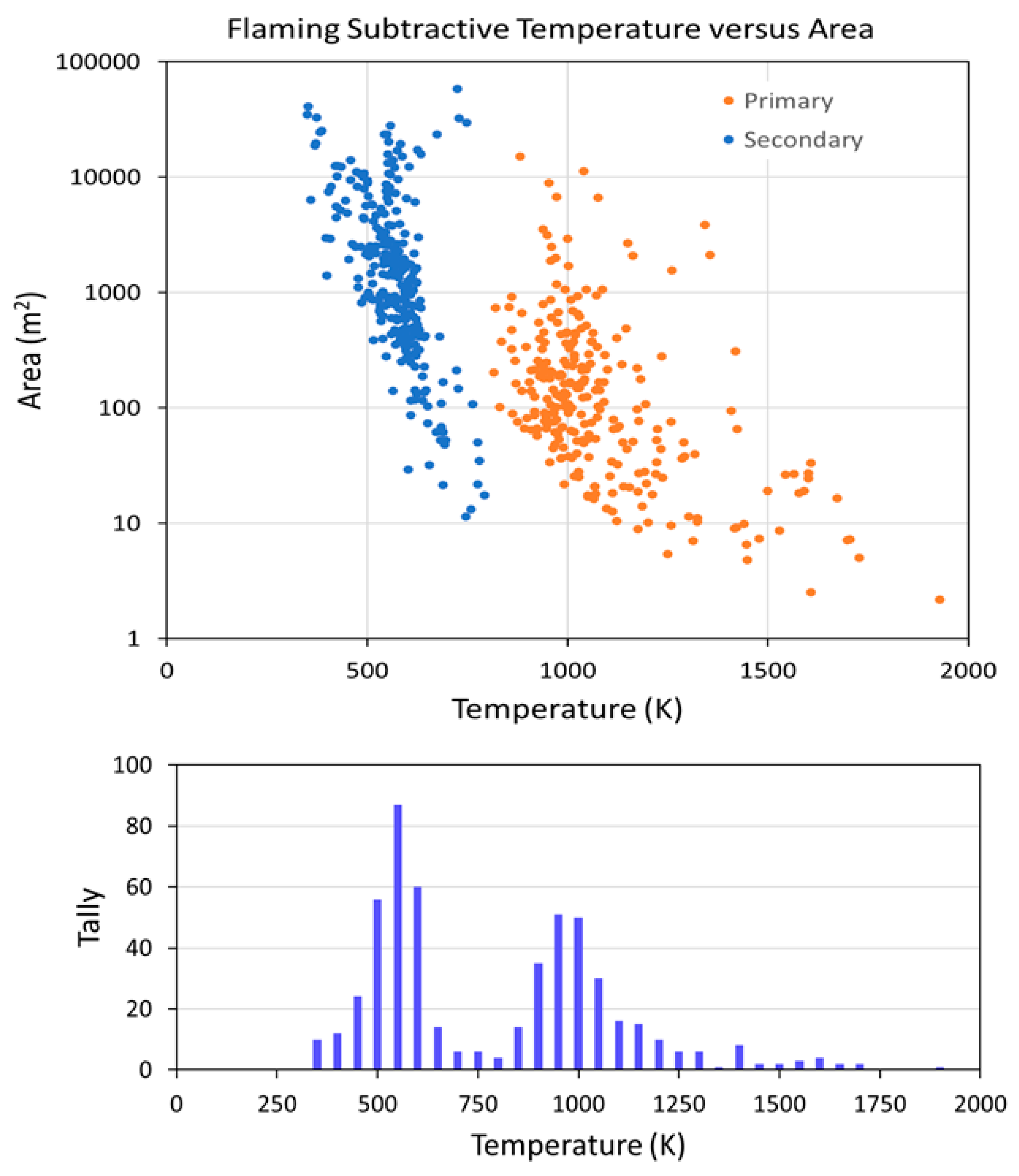
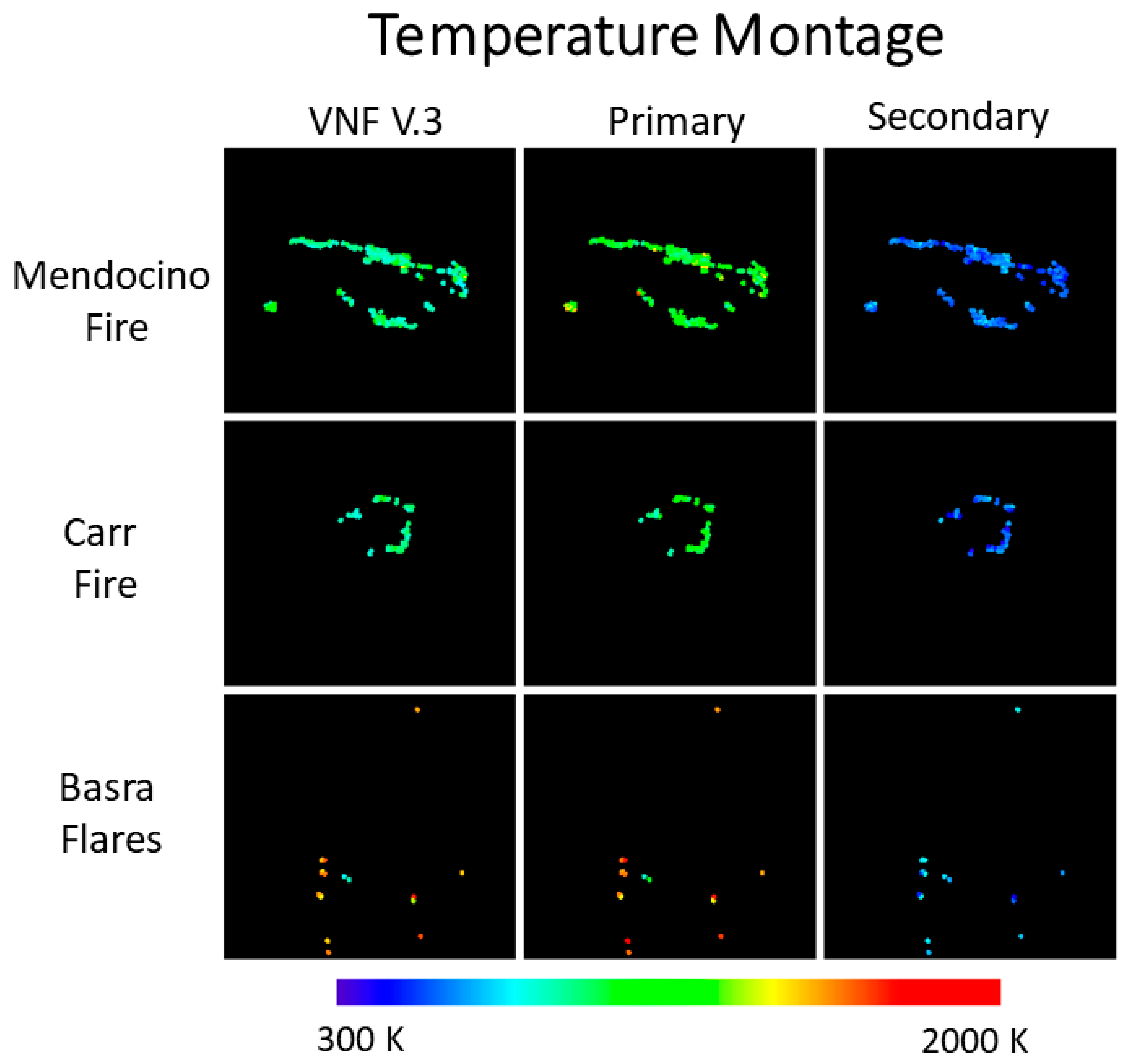
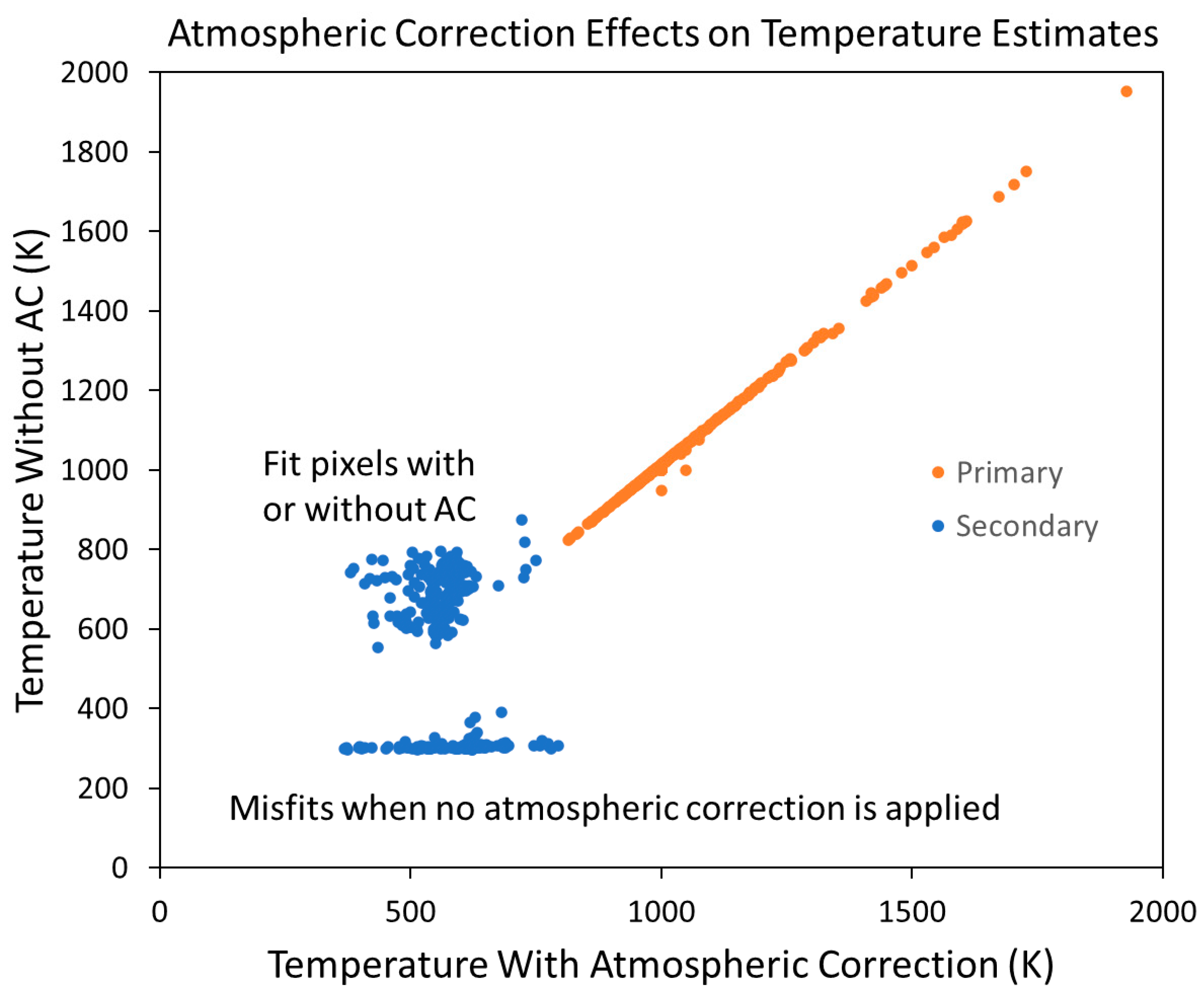

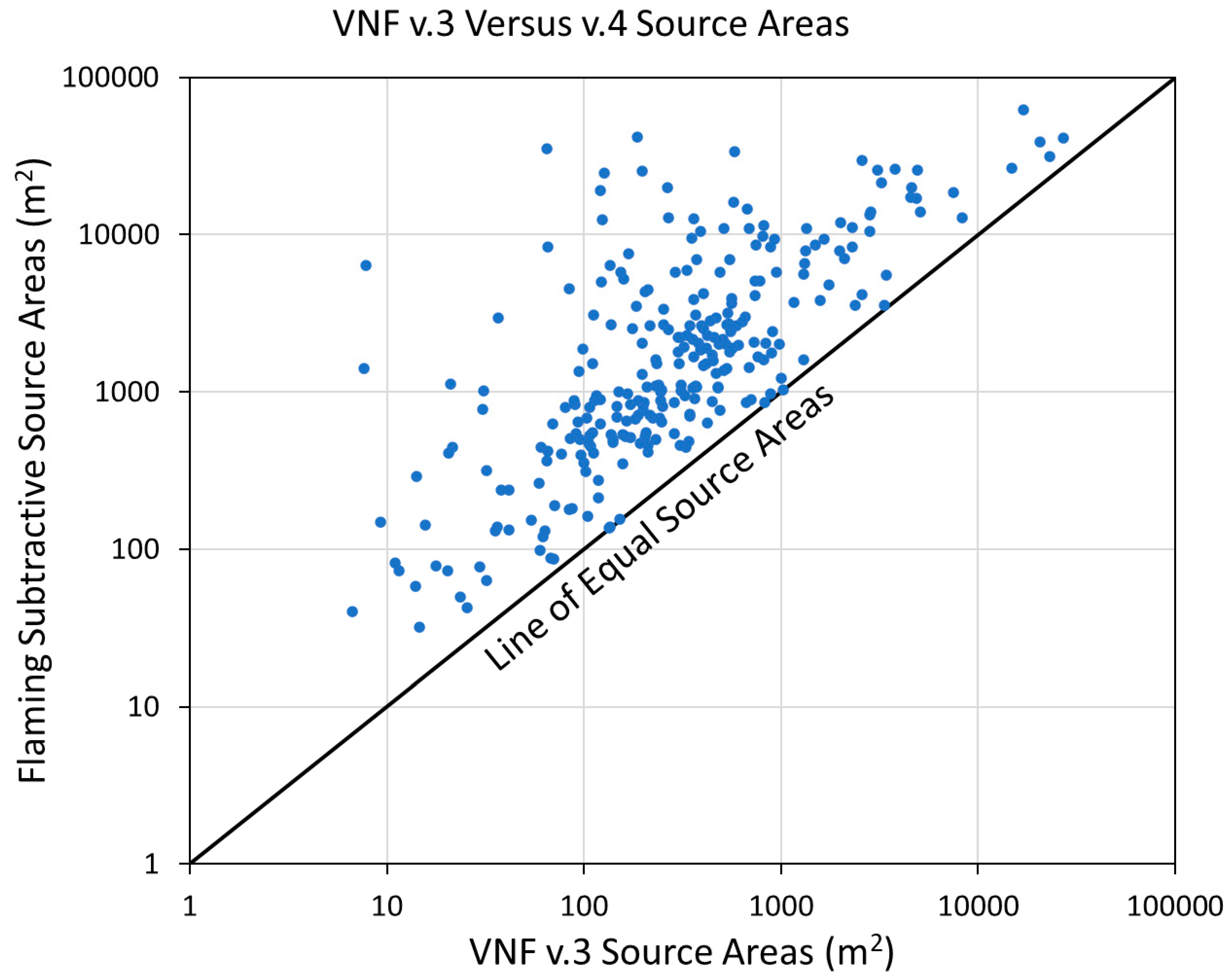

| Band Designation | Range | Central | VNF Detection Limit [14] | Landsat 8 |
|---|---|---|---|---|
| Wavelength (um) | Radiance (watts/m2/sr/um) | Wavelength (um) | ||
| M7 | NIR | 0.865 | 0.034 | 0.865 |
| M08 | NIR | 1.24 | 0.088 | 1.37 |
| M10 | SWIR | 1.61 | 0.036 | 1.61 |
| M11 | SWIR | 2.25 | 0.023 | 2.2 |
| M12 | MWIR | 3.7 | 0.041 | |
| M13 | MWIR | 4.05 | 0.012 | |
| M14 | LWIR | 8.55 | ||
| M15 | LWIR | 10.76 | 10.9 | |
| M16 | LWIR | 12.01 | 12 |
| Name | Location | Date | Latitude | Longitude | VIIRS M10 Filename |
|---|---|---|---|---|---|
| Mendocino Fire | California | 5-August-2018 | 39.275 n | 122.7458 w | SVM10_npp_d20180805_t0948470_e0954274_b35086 |
| Carr Fire | California | 10-November-2018 | 39.7125 n | 121.4875 w | SVM10_npp_d20181110_t0929507_e0935311_b36462 |
| Basra Flares | Iraq | 24-October-2020 | 30.6083 n | 47.325 e | SVM10_j01_d20201024_t2225215_e2226442_b15203 |
| Flaming Subtractive | Tally | Triple Curve Unconstrained | Tally | Triple Curve w/ Flaming K Constraint | Tally | Triple Curve w/ Flaming K and Local Background K Constraints | Tally | Triple Curve w/ Local Background K Constraint | Tally |
|---|---|---|---|---|---|---|---|---|---|
| Negative secondary esf | 66 | Primary .ge. 3000 K | 45 | Secondary less than 1 m2 | 83 | Secondary less than 350 K | 104 | Negative secondary esf | 65 |
| Background under 260 K | 49 | Secondary less than 350 K | 108 | Secondary less than 350 K | 61 | Secondary less than 1 m2 | 94 | Secondary less than 350 K | 117 |
| Secondary less than 350 K | 18 | Secondary less than 1 m2 | 105 | Background less than 260 | 8 | ||||
| Misfits | 133 | Misfits | 258 | Misfits | 152 | Misfits | 198 | Misfits | 182 |
| % Yield | 67% | % Yield | 37% | % Yield | 63% | % Yield | 51% | % Yield | 55% |
Publisher’s Note: MDPI stays neutral with regard to jurisdictional claims in published maps and institutional affiliations. |
© 2021 by the authors. Licensee MDPI, Basel, Switzerland. This article is an open access article distributed under the terms and conditions of the Creative Commons Attribution (CC BY) license (https://creativecommons.org/licenses/by/4.0/).
Share and Cite
Elvidge, C.D.; Zhizhin, M.; Hsu, F.C.; Sparks, T.; Ghosh, T. Subpixel Analysis of Primary and Secondary Infrared Emitters with Nighttime VIIRS Data. Fire 2021, 4, 83. https://doi.org/10.3390/fire4040083
Elvidge CD, Zhizhin M, Hsu FC, Sparks T, Ghosh T. Subpixel Analysis of Primary and Secondary Infrared Emitters with Nighttime VIIRS Data. Fire. 2021; 4(4):83. https://doi.org/10.3390/fire4040083
Chicago/Turabian StyleElvidge, Christopher D., Mikhail Zhizhin, Feng Chi Hsu, Tamara Sparks, and Tilottama Ghosh. 2021. "Subpixel Analysis of Primary and Secondary Infrared Emitters with Nighttime VIIRS Data" Fire 4, no. 4: 83. https://doi.org/10.3390/fire4040083
APA StyleElvidge, C. D., Zhizhin, M., Hsu, F. C., Sparks, T., & Ghosh, T. (2021). Subpixel Analysis of Primary and Secondary Infrared Emitters with Nighttime VIIRS Data. Fire, 4(4), 83. https://doi.org/10.3390/fire4040083









